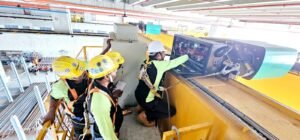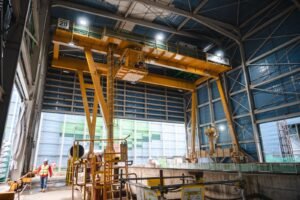Uncategorized
How to Choose the Right Lifting Gear for Your Project
The safety of your workplace and operational efficiency highly depend on the lifting gears you use for lifting heavy materials. The right gear is non-negotiable regardless of your industry, from construction to shipping or manufacturing. However, each industry has different requirements, and you need equipment designed specifically for your needs.
Quality suppliers understand these differences and offer appropriate lifting equipment for various applications. Meeting safety standards while maximising productivity demands proper handling equipment selection from the start. The right gear not only protects your team but also ensures your project runs smoothly. Understanding your options makes all the difference to your industry’s success.
What Are Lifting Gears?
Lifting gears comprise of specialised mechanical devices designed to safely move heavy objects that humans can’t handle manually. These essential tools turn complicated material handling operations into manageable processes that serve multiple industries. Every lifting system contains essential components such as hoists for vertical lifting power, slings for load security, shackles for equipment connection and wire ropes for their strength and flexibility features.
Every piece of lifting equipment has a designated role to play in the complete lifting operation. Modern material handling equipment relies on manual pulleys and electric hoists to provide its essential functionality. Learning basic principles of lifting equipment enables you to select the proper gear that balances safety with operational efficiency for your lifting tasks.
Tips for Choosing Lifting Gears for Your Industry
Before diving into specific equipment, you need to understand your unique requirements. The following sections break down the essential considerations when selecting lifting gear for your industry, focusing on load characteristics, application suitability, safety compliance, and supplier selection.
Know Your Load Type and Weight
Start by carefully assessing what you’ll lift heavy objects. Whether you’re handling a cylindrical drum, an awkward beam, or a flat plate, the shape determines your attachment approach. Identify secure connection points like eyebolts or hooks before selecting equipment. Consider your environment too – outdoor operations require corrosion-resistant gear, while chemical exposure demands specialised materials.
Never compromise on durability when selecting lifting needs. High-quality mechanical devices might cost more initially, but deliver reliability when handling heavy loads. Remember that precise weight calculations prevent dangerous overloading situations. Always match your gear’s weight rating to your heaviest possible load plus a safety margin.
Match the Right Equipment to Your Application
For overhead operations, decide between an electric hoist for regular use or manual chain blocks for occasional lifting. Electric options offer speed and reduced physical effort, while manual systems provide reliability where power isn’t available. Choose lifting slings based on your materials – webbing slings work well for delicate items, while chain slings handle sharp-edged loads.
Select the appropriate strap width for load distribution or add a pulley system for mechanical advantage in tight spaces. Consider specialised attachments like plate clamps for sheet materials or beam clamps for structural work. Hydraulic jacks offer precision in confined areas. The correct lifting tackle makes your job safer and more efficient by perfectly matching your lifting devices to your specific task.
Consider Safety and Compliance
You must regularly inspect all lifting equipment before use to identify issues like fraying, cracks, or deformation. Follow safety standards religiously – they exist to protect your team from preventable accidents. Height safety equipment becomes essential when working above ground level, requiring additional harnesses and anchor points. Use bow shackles when connecting multiple components, and add thimbles to protect rope eyes from wear. Incorporate swivel attachments to prevent dangerous twisting during lifts.
Never bypass industry standards or use equipment beyond its rated capacity. Document all safety procedures and equipment checks to demonstrate compliance with regulations. Comprehensive training ensures everyone understands proper usage techniques. Your commitment to safety directly impacts workplace incident rates.
Choose a Trusted Supplier with Industry Experience
Work with suppliers who understand your specific industry challenges. Their experience helps recommend the perfect solutions for your unique applications. Look for specialists who offer consultation besides simply selling products. Search among different vendors for product specifications and prices to discover competitive rates that maintain quality standards.
Choose suppliers whose products come with comprehensive warranties backed by strong customer service. The best lifting equipment comes from companies invested in ongoing relationships with customers. Check for industry certifications and customer testimonials before making decisions. Reliable, durable equipment ultimately costs less than cheaper alternatives that fail prematurely. Your supplier should become a trusted partner in maintaining your lifting capabilities.
Lifting Gears from Jenmon

At Jenmon, we provide comprehensive solutions to your lifting needs. We support our customers throughout the entire process – from design conception to supply, installation, testing, and commissioning of the lifting equipment.
Our after-sales service team continues to maintain and attend to any service calls from our customers 24/7. As the only Authorised Agent of Verlinde in Singapore, we combine world-class imported equipment with our own manufactured cranes to deliver unmatched quality.
Our product highlights include the following:
- PAP: Girder clamp for loads of 1,000 to 5,000 kg
- PEV: Electronic force gauges with digital readout for loads of 200 to 32,000 kg
- EQUIBLOC: Range of Spring Load Balancers for loads of 0.7 to 55 kg.
Talk to us to explore our workplace lifting equipment and extensive accessory collection that meets your exact requirements.
Final Thoughts
Your choice of lifting equipment directly affects workplace safety levels and operational performance in your facility. By thoroughly examining load types, application requirements, and safety standards, you can protect your team while maximising operational efficiency. Durability and reliability should always outweigh initial cost savings when making these crucial decisions.
Remember that proper lifting operations require ongoing maintenance and regular equipment assessment. Your lifting needs evolve alongside your business, so build relationships with trusted suppliers who understand your industry challenges. Quality safety equipment represents an investment in your operation’s future success.
Take the time to research options thoroughly, consult with experts, and choose solutions that truly match your specific requirements for the best possible outcomes.




